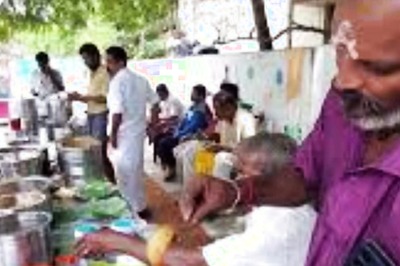
views
Chandra Shekhar Azad visited Sitapur Jail to meet Ganesh Shankar Vidyarthi. Vidyarthi had helped the revolutionaries handle the Kakori Conspiracy Case. So, Azad felt that he would do the same in the Central Assembly bombing case and John Saunder’s assassination case. Vidyarthi suggested that Azad should meet Jawaharlal Nehru in this regard.
On February 27, 1931, Azad met Nehru at Prayagraj requesting help to free Bhagat Singh and others, who were due to be executed on March 23, 1931. Later, he went to Alfred Park to meet a person. Azad died the very same day at Alfred Park (now, Chandra Shekhar Azad Park) after fighting against a large battalion of British forces (more than 80 in number), who had got information about his whereabouts through a spy. Azad shot himself with the last remaining bullet in his pistol in Alfred Park after killing many policemen. He remained ‘azad’ or free till the end. A man who could have enjoyed the pleasures of youth chose to serve our nation instead, sacrificing his personal life and professional ambitions. He died in the service of Bharat Mata.
It is important to note the impeccable contributions of Bhagat Singh. There are very few people in this world (past, present and future) who can replicate the greatness of Singh, who lived for a mere 23 years on this mortal plane but whose contributions to the cause of his motherland will be remembered for aeons to come.
There are many who live long but contribute very less to their societies but Singh was a generous soul. He gave his all for our motherland and was finally martyred in March 1931 in Lahore, when he along with his comrades, Sukhdev Thapar and Shivaram Rajguru were hanged within the Lahore Jail premises secretly, by the dirty British Stooges after 7 pm and their bodies burnt with petrol and thrown into the Sutlej River. They were supposed to be hanged on March 24, however, the hanging was preponed by a day and carried out secretly because the British were afraid of the repercussions of their dastardly act among the Bharatiya people. The extreme cowardice and cruelty of the British was revealed by this tragedy.
Such was his commitment for the causes of the emancipation of his motherland, his desire for an egalitarian and just economic and social society, a society with no communalism, his international outlook and atheistic religious tendencies that he was respected and feared by even his opponents. He left his family and did not even marry. He wholeheartedly served our nation till his last breath along with his beloved comrades –Chandra Shekhar Azad, Shivaram Rajguru and Sukhdev Thapar.
Bhagat Singh rose above all human barriers and boundaries. He rose above race, religion, region and even nationality. It is most likely that had he lived longer, Bharat might have never been partitioned. Singh is revered by both the people of India and Pakistan. He is an icon for Sikhs, Hindus, Muslims, Christians and everyone. Such was the magnificence of his passion for his motherland! He was a leader as popular or even more popular than Mohandas Karamchand Gandhi.
Bhagat Singh wore his heart on his sleeve and was truthful and upright. He never played politics for his personal benefit. He gave his all for our motherland. Singh, the great patriot, socialist revolutionary, atheist and internationalist was born in the village of Banga, which was part of Lyallpur district in undivided Bharat (now in Faisalabad district, Pakistan) on September 27, 1907. His family members were passionately involved in the freedom struggle for Bharat. His parents were Vidyavati Kaur and Sardar Kishan Singh. Some of his relatives had been arrested or imprisoned by the contemptuous British rulers. Bhagat Singh belonged to the Sikh community and his family was economically rich. He displayed a tremendous passion for patriotism from a young age.
The main events which changed the course of the life of Bhagat Singh leading to his early martyrdom at the age of 23 were the following – the Rowlatt Act, the Jallianwala Bagh massacre, the Non-Cooperation Movement, the event at Chauri-Chaura, the Kakori Train Conspiracy, the killing of Officer Saunders and the Central Assembly bombing at Delhi.
The Jallianwala Bagh massacre of April 13, 1919, had a deep impact on him. He was a 12-year-old child at that time. The massacre was a fallout of the draconian Rowlatt Act and the cruelty of evil British General O’Dyer. Thousands of people died in the Jallianwala Bagh massacre in Amritsar, Punjab. On the day of Baisakhi, a large number of people had assembled inside the Jallianwala garden to protest against the Rowlatt Act and the arrest of some leaders. They were brutally massacred. Singh was shaken by the brutality of the illegitimate British masters. His entire life was against imperialism and pro-revolution. His endearing and unchanging slogans were ‘Inquilab Zindabad’ and ‘Samrajyavad Murdabad’ (Long Live Revolution and Down with Imperialism).
Singh was always a courageous and intellectual person from a young age. He studied at Dayanand Anglo-Vedic School and later at National College at Lahore and not in any British-run school or college. He was a patriot above everything else. He would also become an internationalist and a social revolutionary inspired by Karl Marx and the Russian Bolshevik revolutionary, Vladimir Ilyich Lenin. Bhagat Singh was an atheist by belief inspite of having been born in an orthodox Sikh family and a socialist in his ideological leanings. He was never a communist.
He was also a voracious and extensive reader, who read on different topics such as polity, economy, social life and culture. He was an enthusiastic participant in the Non-Cooperation Movement, which began in 1919. He was very unhappy when freedom fighter Lala Lajpat Rai was lathi-charged on October 30, 1928. He along with many other patriots felt devastated when the revered Lalaji succumbed to head injuries on November 17, 1928. For, the first time, doubts entered Bhagat’s mind regarding the ability of Gandhi ji and whether his ahimsa policy would lead to the emancipation of Bharat. Truth be told, all Bharatiya people know now that it was not merely Gandhiji’s method of ahimsa which got freedom for Bharat but also the himsa or violence policy followed by Bhagat Singh and other revolutionary freedom fighters like Chandra Shekhar Azad, who were inspired by Veer Damodar Savarkar’s book, ‘First war of Indian Independence in 1857’ and the travails of Savarkar. Later, SC Bose would take the cudgels against the British, inspired by revolutionary freedom fighters like Bhagat Singh and Savarkar.
Singh was very unhappy when Gandhi called off the Non-Cooperation Movement after the incident at Chauri-Chaura. On February 4, 1922, at Chauri-Chaura, an angry Bharatiya mob set fire to a police station. Three civilians and 22 policemen died in the incident. The uncomfortable truth that Gandhi comfortably forgot was that the mob had only retaliated to the continuous persecution of innocent indigenous Bharatiya people by an illegitimate, dastardly British imperialism. The traders from thousands of kilometres from the Indian sub-continent were pretending to be legitimate rulers. The truth was that the police had opened fire upon a large group of protestors participating in the Non-Cooperation Movement. The burning down of the police station was only an act of retaliation. Bhagat understood that Bharat would never be able to get independence through non-violence. He understood that Bharat would need to adopt a multi-pronged strategy to get independence. To put it simply, Bhagat Singh was disillusioned by Gandhi’s appeasement tactics and non-violent principles.
Singh met his fellow revolutionaries – Sukhdev Thapar and Bhagawati Charan – during his college days at National College, Lahore. He also made other life-long friends like Chandra Shekhar Azad and Shivaram Hari Rajguru. It would take the efforts of stalwarts like Azad, Singh and Rajguru along with countless other revolutionaries like Veer Savarkar, Rash Behari Bose and Subhas Chandra Bose to win independence for Bharat.
Singh joined the Kirti Kisan Party in 1926 in Lahore. He started writing for ‘Kirti’ and wrote against the atrocities of the British. He also started the Naujawan Bharat Sabha in 1926. The main aim behind the formation of the sabha was to bring the soldiers and farmers of Bharat together and to unite people from all religions with the final aim of freeing Bharat from British rule and bringing about socialism in Bharat. Bhagat wanted the British to leave and also wanted Bharat to be ruled by a government which would provide both social and economic justice to its people. Towards this goal, Bhagat paid a huge personal price.
His refusal to marry caused much sorrow and consternation among his parents and relatives but Bhagat stood his ground and did not yield to emotional blackmailing of any kind. He left his parental home in Punjab and went to Kanpur in present-day Uttar Pradesh. Singh’s revolutionary career got a fillip after he went to Kanpur. It was in present-day Uttar Pradesh where he met the revolutionary stalwarts, Chandra Shekhar Azad, Shivaram Rajguru and others.
In 1927, the Kakori train conspiracy was carried out by the HRA – Hindustan Republican Association. Ram Prasad Bismil and four other revolutionaries were hanged and 16 were given life imprisonment. In the same year, the Simon Commission came to India. Protests were carried out. Lala Lajpat Rai was one of the protesters. He was lathi-charged by the Police after which he died.
Singh and other revolutionaries became very angry seeing all this injustice and planned revenge for Lala ji’s death. The revenge was planned by the revolutionaries, especially by Azad, Singh, Rajguru and Jai Gopal. They all decided to be a part of the assassination of police officer James Scott, who had ordered the lathi-charge on Lala ji. Revolutionary Jai Gopal was designated with the duty to identify the officer. Unfortunately, on the day of the assassination, Jai Gopal wrongly identified Officer Saunders as Officer Scott. Singh and Rajguru mistakenly killed Officer Saunders in Lahore. This revolutionary act led by Azad was indirectly inspired by revolutionaries like Ram Prasad Bismil and Veer Vinayak Damodar Savarkar. They would be forerunners of the revolutionaries Rash Behari Bose and Subhas Chandra Bose. Thus, there was a constant rising of revolutionaries.
The first round of revolutionaries included Savarkar. The second and third rounds of revolutionaries included members of HRA and then HSRA led by Azad, Singh and others. Thus, it would be a horrible fallacy to think that only Gandhi and a handful of leaders got freedom for India. Credit should be given where it is due. In fact, it was Singh who initially brought the idea of ‘Vasudhaiva Kutumbakam’ or ‘The World is One Family’. Swami Vivekananda too believed in this and the present Central dispensation, too follows this motto.
After the death of Saunders, the police searched for the perpetrators everywhere but were not successful. Singh, Azad etc were masters of deception and evaded the police by disguising themselves well. There was a need to rebuild HRA. Soon, Bhagat met Azad. The two stalwart freedom fighters decided to merge the Naujawan Bharat Sabha and the Hindustan Republican Association. In September 1928, there was a secret meeting at Feroz Shah Kotla, Delhi and the merged entity was born – the Hindustan Socialist Republican Association. The word ‘socialist’ had been added.
The tyrannical, evil and cunning British imperialists were unable to catch Singh or his comrades on their own. Finally, it was Singh and Batukeshwar Dutt, who after their bombing of the Central Assembly in Delhi in 1929, voluntarily surrendered themselves before the Police. This was to show their opposition to the draconian and anti-proletariat bills – the Trade Disputes Bill and the Public Safety Bill. The Trade Disputes Bill was against the rights of the workers and the Public Safety Bill was anti-people.
A lot of people have tried to portray Bhagat Singh as a communist. However, it is contrary to the truth. While it is true that Singh had socialistic tendencies, it is untrue and unfair to say that he was a communist. The Leftists have always tried to project Singh as a Leftist, which is nothing but setting a false narrative. Although he was pro-socialist, he was not a Marxist. Both the CPI and the CPI(M) have tried to appropriate the legacy of Singh but have not been successful so far. He never advocated communism.
According to Swami Sumedhanand Saraswati, Arya Samaj played an important role in shaping Singh. According to him, Singh was influenced by the ideals of Arya Samaj. Schooling at DAV, Lahore must have influenced young Bhagat in multiple ways.
Shivaram Hari Rajguru was born on August 24, 1908, in Khed, in what is present-day Pune district on the banks of the river Bheema. His parents were Parvati Devi and Harinarayan Rajguru. He was born in a Marathi Deshastha Brahmin Hindu family. His parents were pious and simple souls. Patriotism ran in in his blood. Rajguru obtained his primary education at Khed. He studied at New English High School in Pune. He was patriotic since childhood. He did not approve of Bharat being ruled by an alien imperialistic regime.
He was a member of Seva Dal. He attended a training camp by Dr MS Hardikar at Ghatprabha. He became a revolutionary after joining HSRA, a group of freedom fighters founded by Sachindra Sanyal, Ram Prasad Bismil and others. He became close to other revolutionaries in HSRA like Bhagat Singh and Sukhdev Thapar. Rajguru was greatly inspired by the inimitable Chandra Shekhar Azad, who was a great freedom fighter.
Singh, the daring revolutionary from Punjab was inspired by Kartar Singh Sarabha, the founder of the Ghadar Party. Rajguru, Singh and Thapar were the beloved associates of Azad.
March 23, 1931, was indeed an extremely sad day for Bharat Mata, who lost three of her most precious children – Bhagat Singh, Sukhdev Thapar and S Rajguru. They were cremated at Hussainiwala on the banks of the Sutlej River in Ferozepur in Punjab. There are tens of thousands of people, who throng the memorial in Hussainiwala to pay homage to these great freedom fighters.
The sacrifice of Chandrashekhar Azad, Bhagat Singh, Rajguru and Sukhdev Thapar is more important now in the context of the Amrit Mahotsav or the completion of 75 years of independence, wherein we need to recall the sacrifice of our freedom fighters. Did the freedom fighters die in vain to witness this extreme rise in human population, falling standards of culture and morality, extreme levels of pollution and corruption, degeneration of the environment, rising crime rates, rise in the use of intoxicants and bad habits, lack of humanity, courtesy and kindness etcetera?
Khed has been renamed as Rajgurunagar. In April 2023, the Maharashtra government told a large panel of 30 members headed by the Pune Divisional Commissioner to submit a fresh plan for the redevelopment of Shivaram Hari’s ancestral home at Rajgurunagar, 45 km from Pune. The state government of Maharashtra has already committed Rs 150 crore for the redevelopment plan and has sanctioned Rs 30 lakh for carrying out repairs to the House of Rajguru, which will be converted into a memorial. Rajguru’s Memorial is to be developed in the heart of Rajgurunagar. The entrance gate to the memorial is complete and work is on to complete the rest of the memorial on time.
Prime Minister Narendra Modi has appreciated the contributions of our great freedom fighters and has poured encomiums on Chandra Shekhar Azad, Shivaram Rajguru, Bhagat Singh and Sukhdev Thapar on various occasions. There is a memorial dedicated to S. Rajguru spread over 2,788 square metres of land. There is also a college named after S. Rajguru, known as Shaheed Rajguru College of Applied Sciences for Women. It is situated in Delhi and is affiliated to Delhi University. The legacy of Rajguru is illustrious and lasting.
Concluded
Dr. S Padmapriya, Ph.D, Author, Educator and Thinker, from Chennai. Views expressed in the above piece are personal and solely those of the author. They do not necessarily reflect News18’s views.



















Comments
0 comment